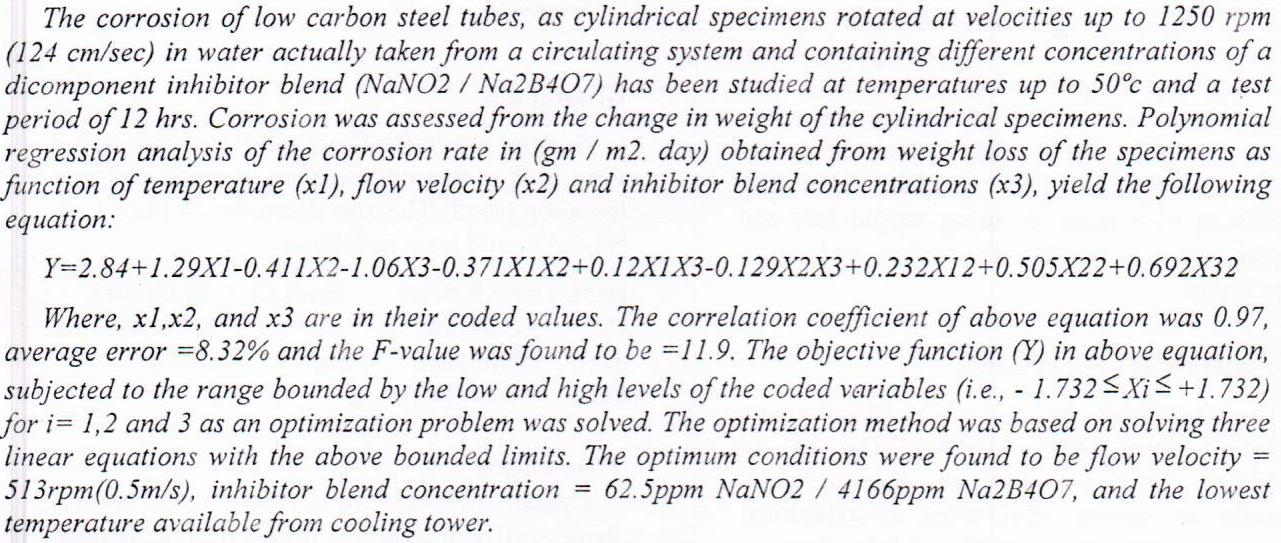
 (24)
(24)
 (21)
(21)
Ficus (FIC) leaf extract used as corrosion inhibitor for carbon steel alloy (C.S) in two corrosive environments (saline and acidic) with four concentrations (1, 2, 3 and 4 ppm) at varied temperature range between (298-328 K) using electrochemical polarization measurements. The importance of this work focused on the use the green chemistry that is far from the chemical materials effect. The results of polarization presented the FIC inhibitor consider a mixed type (anodic and cathodic) inhibitor. Tafel curve used to evaluate the corrosion inhibition activity. In a saline medium, the best inhibitor efficiency reaches to (87%) in 2 ppm and IE% reach to (99%) for HCl medium inhibited by 1ppm. Langmuir isotherm obeys the study by thermodynamic pa
... Show More (28)
(28)
 (16)
(16)
 (8)
(8)
 (7)
(7)
There are no single materials which can withstand all the extreme operating conditions in modern technology. Protection of the metals from hostile environments has therefore become a technical and economic necessity.
In this work, for enhancing their wear-resistance, boride layers were deposited on the surface of low carbon steel by a pack cementation method at 850 °C for (2, 4, and 6) h using vacuum furnace. The boronizing process was achieved using different concentration of boron source (20, 25, and 30) % wt. into coating mixture to optimize the best conditions which ensure the higher properties with lower time. The coating was characteristic by X ray diffraction (XRD), and it is confirmed t
... Show MoreIn this work, corrosion parameters were evaluated using potentiodynamic polarization curves. In order to determine corrosion parameters of potential and current density of the interesting metal, carbon steel, environmental conditions of external corrosion of buried carbon steel pipeline in Iraqi soil were prepared in the laboratory using simulated prepared conditions. Solutions of sodium chloride at different concentrations (300, 1100, 1900, 2700, and 3500 ppm) were used. pH of solution were acidic at pH =5, and alkaline at pH = 9. Laboratory conditions were similar to those of Iraqi soil where the pipelines were buried. Temperature was constant at 20 °C. Potentiodynamic polarization curves, of potential vs. log current density, were ob
... Show MoreAbstract
Magnetic abrasive finishing (MAF) is one of the advanced finishing processes, which produces a high level of surface quality and is primarily controlled by a magnetic field. This paper study the effect of the magnetic abrasive finishing system on the material removal rate (MRR) and surface roughness (Ra) in terms of magnetic abrasive finishing system for eight of input parameters, and three levels according to Taguchi array (L27) and using the regression model to analysis the output (results). These parameters are the (Poles geometry angle, Gap between the two magnetic poles, Grain size powder, Doze of the ferromagnetic abrasive powder, DC current, Workpiece velocity, Magnetic poles velocity, and Finishi
... Show MoreA novel analytical method is developed for the determination of azithromycin. The method utilizes continuous flow injection analysis to enhance the chemiluminescence system of luminol, H2O2, and Cr(III). The method demonstrated a linear dynamic range of 0.001–100 mmol L-1 with a high correlation coefficient (r) of 0.9978, and 0.001–150 mmol L-1 with a correlation coefficient (r) of 0.9769 for the chemiluminescence emission versus azithromycin concentration. The limit of detection (L.O.D.) of the method was found to be 18.725 ng.50 µL−1 based on the stepwise dilution method for the lowest concentration within the linear dynamic range of the calibration graph. The relative standard deviation (R.S.D. %) for n = 6 was less than 1.2%
... Show More (1)
(1)
 (1)
(1)
The V2O5 films were deposited on glass substrates which produce using "radio frequency (RF)"power supply and Argon gas technique. The optical properties were investigated by, UV spectroscopy at "radio frequency" (RF) power ranging from 75 - 150 Watt and gas pressure, (0.03, 0.05 and 0.007 Torr), and substrate temperature (359, 373,473 and 573) K. The UV-Visible analysis shows that the average transmittance of all films in the range 40-65 %. When the thickness has been increased the transhumance was decreased from (65-40) %. The values of energy band gap were lowered from (3.02-2.9 eV) with the increase of thickness the films in relation to an increase in power, The energy gap decreased (2.8 - 2.7) eV with an increase in the pressure and
... Show More (3)
(3)
Abstract: Objectives: To investigate the effect of temperature elevation on the bonding strength of resin cement to the zirconia ceramic using fractional CO2 laser. Background: Fractional CO2 laser is an effective surface treatment of zirconia ceramic, as it increases the bonding strength of zirconia to resin cement. Methods: Thirty sintered zirconia discs (10 mm diameter, 2 mm thickness) were prepared and divided to three groups (N=10) and five diffident pulse durations were used in each group (0.1, 0.5, 1, 5 and 10 ms). Group A was treated with 10 W power setting, group B with 20 W and group C with 30 W. During laser irradiation, temperature elevation measurement was recorded for each specimen. Luting cement was bonded to the treated z
... Show More